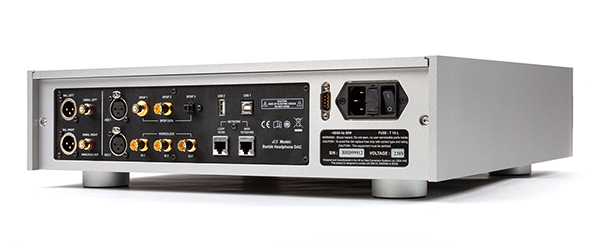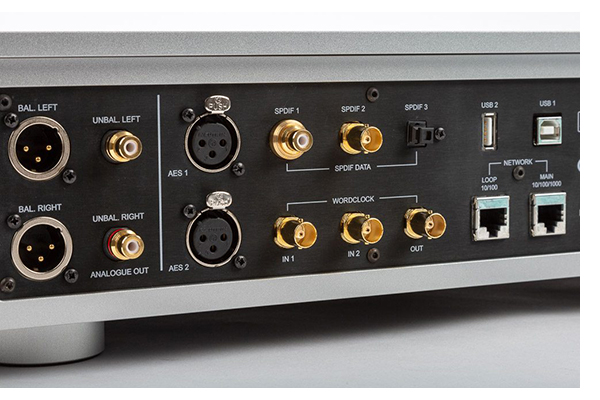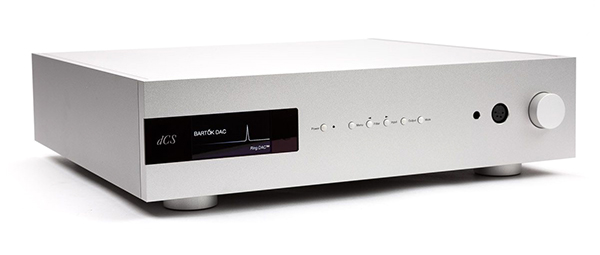The dCS Bartok DAC A Substantial helping of excellence
By Jeff Dorgay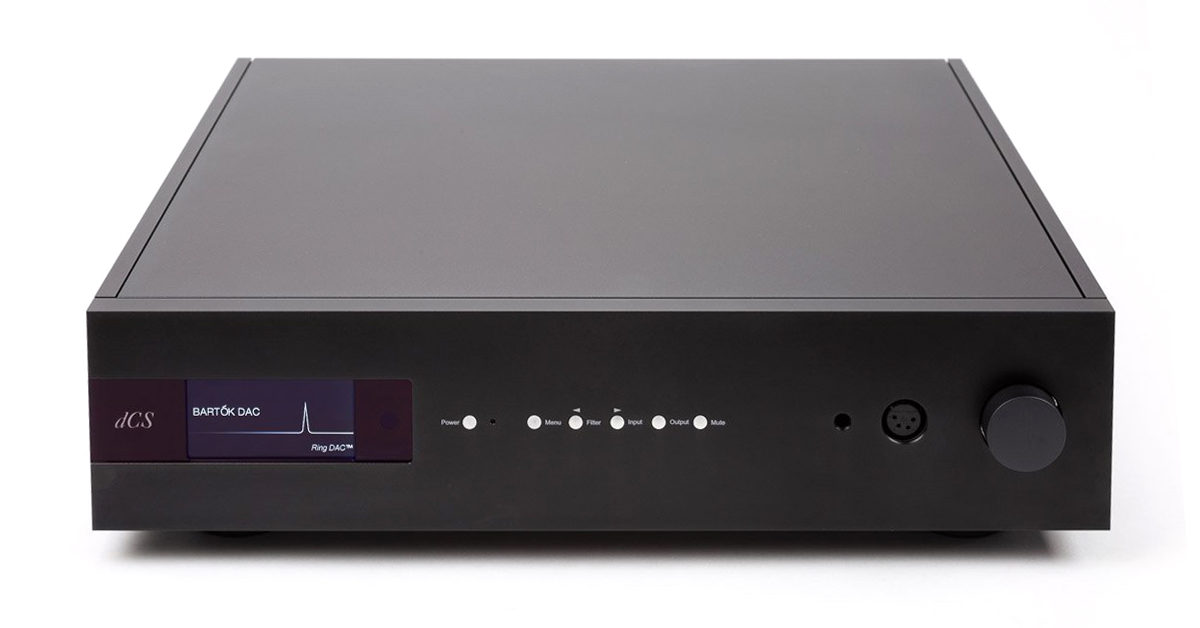 Listening to the delicacy of Allison Miller’s drumming in Boom Tic Boom, in my living room system, it’s easy to see how this DAC can be the end of your digital journey.
Listening to the delicacy of Allison Miller’s drumming in Boom Tic Boom, in my living room system, it’s easy to see how this DAC can be the end of your digital journey.
Like every other dCS DAC I’ve owned or reviewed, they always manage to hit a perfect tonal balance, combined with wide dynamic range and a natural presentation that never feels digital at all. Good as their last entry-level piece the Debussy was ($11k about 8 years ago), the new Bartok at $13,500 (and $15,000 with a built-in headphone amp) offers quite a bit more. By comparison, many of your favorite automobiles have gone up in price by a much greater percentage.
The Bartok’s sonic signature is similar to the Vivaldi but the Vivaldi is further refined. The Bartok reminds me much more of my former Paganini in terms of the ease it presents. Much like my reference dCS Vivaldi One, the Bartok just sounds like music. There’s no “pretty good for digital” stuff going on here. dCS’ John Quick had this to say about the similarity of the Bartok in their lineup:
“Bartok and Rossini share the same processing and RingDAC analog boards, so overall, they have the same processing capacity. The differences between the units (that affect their cost and ultimately their overall performance) are literally down to the Bartok having half the power supply and the chassis being far less expensive. The Bartok’s construction overall is less complicated, using thinner metal. It uses a folded metal internal chassis wrapped in aluminum side and top panels; and although the front panel seems like a thick hunk of aluminum like everything else, it’s actually a very thin cap that either includes the punch-outs for the headphone outputs or not.”
A long-term investment
It’s been argued elsewhere that components like the dCS Bartok will only be purchased by the wealthy, in reference to its $13,500 price tag. ($1,500 more, if you want the internal headphone amplifier, and I highly suggest that you spend the extra- you won’t regret it)
However, I submit that $13,500 – $15,000 isn’t out of reach for all but the well-heeled (read my article on “motorcycle money” here). Call me crazy, but I’m guessing you probably didn’t wake up today and say “I’m gonna buy a $15,000 DAC today.” Most audio enthusiasts don’t start there. Some do, but most don’t. Most of us work our way up the ladder. More realistically, you’re probably trading in a $3k-$8k DAC and moving up to what might be your last. dCS’ programmable architecture goes a long way towards making an investment as future proof as digital technology can be.
Over the nearly ten years I owned the Paganini stack, numerous upgrades were only an upload away, giving me a new DAC every time. You can read more about dCS’ approach and technological solutions here at their website.
This is an excellent time to make an investment like this because Roon is well implemented, there are several excellent streaming services available (directly via dCS’ own Mosaic App should you not go the Roon route), and all of the dCS players have proprietary fully-implemented MQA. We could have a dodgeball game to the death about MQA, but if you are a fan, rest assured that dCS has done a fantastic job at decoding MQA. I’ll even put the Nomex suit on and go as far as to say they’ve even outdone Meridan on MQA decoding ability – these files though both of the dCS DACs here, sound more lifelike than they have on any other MQA equipped box we’ve heard.
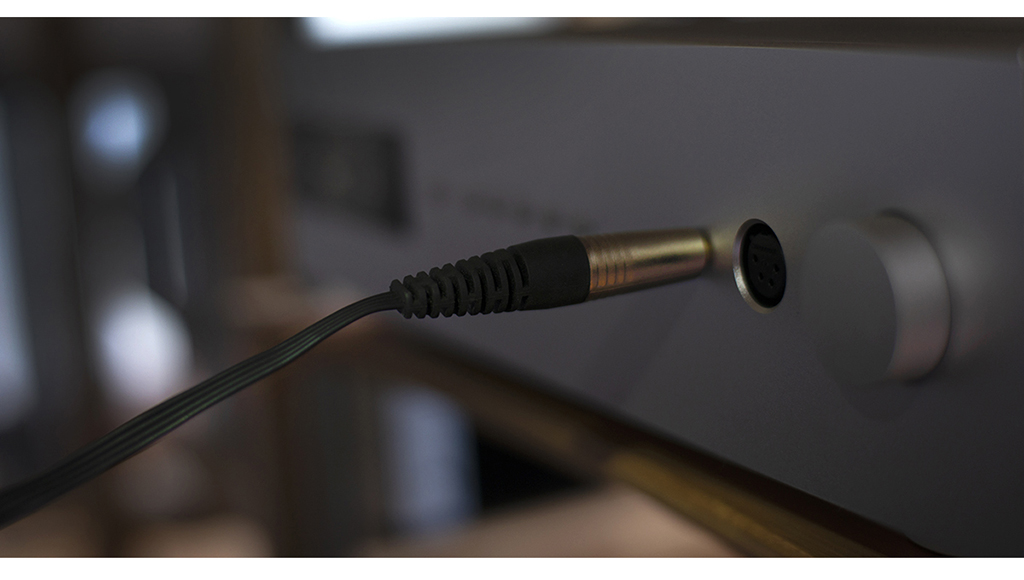 Just grab your favorite phones
Just grab your favorite phones
Because the Bartok has already started achieving a lot of fanfare in the headphone world, let’s start here. As dCS’ first entry into this world, they’ve built a brilliant product. The Bartok’s full class-A headphone amplifier drives everything from my Koss Pro-4AAs that I’ve had since high school to the new Focal Utopias to perfection. You’d probably spend more than $1,500on a premium interconnect and power cable to add a headphone amplifier of comparable performance to a Bartok based system, so it’s almost like getting a fab headphone amplifier at no extra charge- and you don’t need to find more rack space. How’s that for justification?
After exhausting auditioning with about 20 different pairs of phones in the $50 – $4,000 range, I don’t need a better headphone amplifier than the one built in the Bartok. A couple of the top choices from Luxman ($4,995) and Woo Audio ($16,000) reveal a little bit more music, but nowhere near enough for this moderate headphone user to ever justify the additional cost. The front panel features a standard ¼-inch headphone jack and a 4-pin balanced jack. While this won’t cover every single headphone out there, all of the premium headphones on the market have one of these two options (if not both) available (and most have detachable cables allowing for adapting to either).
Headphone use couldn’t be more straightforward. Plug into the front panel and switch the Bartok’s output from line to headphone, and then use the knob on the front panel as volume, or control from your mobile device or laptop with whatever app you are using for playback.
Even the most fanatical of my headphone pals came away highly impressed with the Bartok’s performance. Those of you living in tight quarters, tight enough that you can’t afford the space for a power amplifier and speakers right now, would do well to grab a Bartok, a Roon subscription, and a few of your favorite streaming services.
This leads to my only complaint with the Bartok- it would be lovely if dCS would add a single analog input, so those needing just one input could use it as a standalone preamplifier, or those going strictly for the headphone experience, could add a phonostage too. If you’re all digital, the Bartok is pretty incredible.
Rather than seeing the Bartok as a $15,000 headphone amp that happens to be a remarkable DAC, I see it as a destination DAC that’s a steal at $13,500 and even more so with the addition of the headphone amp. Perspective is everything.
After coming off a year with the Rossini and now nearly a year with the Vivaldi ONE, the only thing the Bartok doesn’t offer that the other two larger and more expensive players in the lineup offer are scale and some ultimate top-end refinement. Some of this refinement can be achieved by adding a dCS external clock.
The sense of scale comes from bigger power supplies, isolation of functions to individual chassis and the added electrical and mechanical isolation that comes with taking core functions to separate chassis. The progress dCS has made here is astounding. Again, Mr. Quick chimes in, offering some more insight: “We are getting better at trickling down more of the sound of our flagship in our current offerings, and Bartok is really special in that regard. Considering it has 6-7 years of R&D ahead of it from Vivaldi and Rossini – far ahead of anything else we’ve done- versus the 2.5-3 years that separated Scarlatti and Debussy… that definitely made a big difference. Beyond that, where we’ve taken the RingDAC in the latest series is also a primary contributor. We could not have made nearly the same overall improvement in changing the mapping algorithm (as we did in Vivaldi and Rossini v1 versus v2) in the older generation products.”
It’s all about resolution
Having the unique ability to compare the Bartok side by side as the anchor to a very nice $50k system (which is where I suspect most Bartoks will end up) and my reference system, worth nearly ten times this much, illuminates the differences clearly.
In my primary reference system, that has a much broader dynamic capability, more low-level resolution, and a magnificent soundstage, the Bartok makes a great showing. For many analog crazed audiophiles I know that are primarily analog, but would still like digital, this could be an excellent choice.
Regardless of choosing delicate, small ensemble choral music, or the most raucous rock, starting with the Bartok feels just fine. But then switching up to the Vivaldi One shows precisely where the limits of the Bartok lie. Yet going back to the system in my living room, which is unable to resolve as much musical information, the delta between the two is not nearly as vast.
The point here is that the core musicality of the Bartok is highly similar to the bigger boxes in the dCS range, and that’s what I appreciate. Some manufacturers are not nearly as good at delivering a linear increase in performance as you go up the range. The Bartok is at the top of its class for the price asked, as are the Rossini, Vivaldi ONE and full-blown, four box Vivaldi – as it should be. There’s no law of diminishing returns if you have a system capable of resolving the difference.
The Bartok can accommodate any digital source you’d like to connect, via its RCA, Coax, or optical SPDIF inputs, single or dual AES inputs, USB or network inputs. That’s right, it’s got a fully capable streamer built in that will access your UPnP network and bring files in from your NAS or straight from your network.
The Bartok has a fully balanced, class-A output stage in addition to the headphone amplifier, and there are balanced XLR and standard RCA outputs, that are both variable. More about that in a bit.
Our experience with the Vivaldi ONE, the Rossini, and Bartok is that the best results are streaming music files right from the network. Those not wanting to pony up for a ROON subscription can use dCS’ own app, which works well and sounds excellent, though lacks the ultimate functionality of ROON. It’s also incredibly handy that you can chain another network device through the Bartok. I use a Naim Uniti Core for CD ripping and offline storage in addition to my NAS, so this is a perfect way to keep the Uniti Core close by.
Excellent luck was also had with a variety of different CD players as transports. Those who want to keep it all dCS might consider a used dCS transport for their disc needs, and if you use a Paganini transport with the dual AES connection, native SACD playback is possible. There are no limitations to digital playback with the Bartok. You can even connect to it as an Airplay zone!
Pre or not to pre
The ultimate question for some will be whether to use the Bartok as a standalone preamplifier, forgoing a linestage/preamplifier, or putting one in the system. Conventional wisdom suggests that less is more, but digital volume controls are always a touchy thing. At extremely low listening levels, they tend to lose resolution. Where the Vivaldi One can, in fact, be used without a line stage, if you are only concerned with digital playback, the Bartok is pretty good.
Ultimately, this is the other area where the entry-level Bartok is bested by the top dCS player. In my living room system when playing the Bartok directly into the BAT VK 56SE power amplifier and Focal Kanta no.3s, adding a preamplifier made a slight difference, offering up a little bit more spaciousness and definitely a smidge more warmth at very low-level playback. It was easier to notice the minute level of flatness there at the lowest level after going back to having a tip-top preamplifier in the system, but it will depend on your needs.
However, switching from the Kanta no.3s to the much larger and more resolving Focal Stella Utopia Ems, the jump in performance added by our Nagra Classic Preamplifier was unmistakable, especially in the area of tonal contrast and saturation. And of course, low-level playback is warmer and more full-bodied.
It’s about music
As I’ve said before, the dCS DACs have always deliver supreme musicality, and I have hung my hat on their products, using them as a reference tool for over a decade. However, what I love about dCS is the way they serve the music and not the other way around. This is a player than I can listen to for 12-16 hours a day (and have on many occasions) with zero fatigue.
dCS does an outstanding job at presenting music with a tonality that is dead center in the middle of the scale. Their products (and the Bartok is no exception) are neither warm and romantic nor overly bright, bleached or harsh. Hitting the tonality bullseye is tougher than it sounds, but they manage to pull it off every time.
Every other musical parameter is equally well represented. Rather than go on at length with tracks you may or may not know or like, the best way to see what I mean is to go to your dCS dealer and give the Bartok a listen.
Is it for you?
Returning to our original conversation, you don’t have to be an aristocrat to have a dCS Bartok of your very own. If you love music, and you want a top-quality digital front end that will offer enough performance to stay put, the Bartok is a winner. The performance that it provides more than justifies the price asked. dCS has put a considerable helping of their top technology in a package that outperforms many far more expensive boutique DACs.
Best of all, the customer service and ongoing support that comes with a dCS product assures that this is a digital player you will enjoy for years to come. Highly recommended. And yes, spring for the headphone amp!
$13,500. ($16,250 with headphone amplifier)
Peripherals
Preamplifier Nagra Classic Preamplifier
Amplifier Nagra Classic Amplifier
Speakers Focal Kanta no.3 and Focal Stella Utopia EM
Cable Cardas Clear




